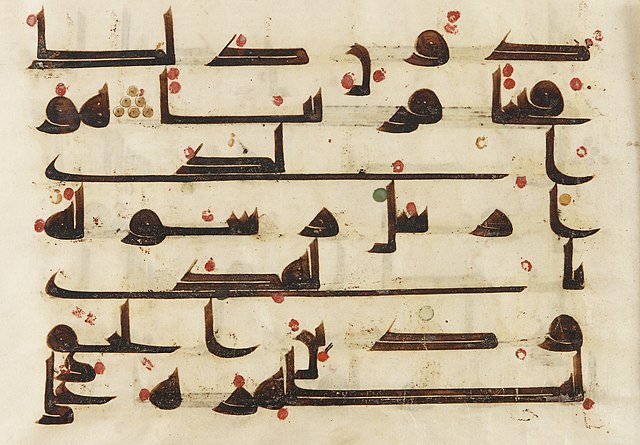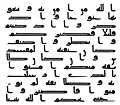കുഫിക്
അറബി ഭാഷ സ്ക്രിപ്റ്റുകളിലെ ഏറ്റവും പഴക്കം ചെന്ന കാലിഗ്രാഫിക് രൂപം From Wikipedia, the free encyclopedia
Remove ads
വിവിധ അറബി ഭാഷ സ്ക്രിപ്റ്റുകളിലെ ഏറ്റവും പഴക്കം ചെന്ന കാലിഗ്രാഫിക് രൂപമാണ് കുഫിക്. പഴയ നബാറ്റിയൻ ലിപിയിലെ പരിഷ്കരിച്ച രൂപമാണ് ഇത്. ഇറാഖിലെ കുഫായിൽ ഏഴാം നൂറ്റാണ്ടിന്റെ അവസാനത്തോടെ കുഫിക് വികസിപ്പിച്ചു.[1]


Remove ads
ചിത്രശാല
- Page from a Qur'an in Kufic style, 8th century (Surah 15: 67–74)
- Kufic script from an early Qur'an manuscript, 8th-9th century. (Surah 7: 86–87)
- Manuscript of the Surat Maryam of the Qur'an; Kufic script on gazelle skin, 9th century. (Surah 19: 83–86)
- The leaves from this Qur'an written in gold and contoured with brown ink have a horizontal format. (9th century)
- Bowl with Kufic Inscription, 9th century - Brooklyn Museum
- Bowl with Kufic Calligraphy, 10th century - Brooklyn Museum.
- 11th-century gold Fatimid armlet, inscribed with good wishes in the Kufic script, (Syria).
- Kufic alphabet, from Fry's Pantographia (1799)
- Geometric Kufic from the Bou Inania Madrasa (Meknes); the text reads بركة محمد or barakat muḥammad, i.e. Muhammad's blessing.
- Another example of geometric or square Kufic script, showing four instances of the name Muhammad (in black) and four times Ali (in white); often used as a tilework pattern in Islamic architecture
- Inscription in Kufic (743). The Walters Art Museum.
- Banna'i on a minaret – a repetitive pattern of square Kufic inscriptions.
- Drawing of an inscription of Basmala in Kufic script, 9th century. The original is in the Islamic Museum in Cairo (Inventar-Nr. 7853)
- The flag of Iraq (2008)
- The flag of Iran (1980)
- Arabic text of the Shahada in square Kufic script, shown as buildings topped with minarets.
Remove ads
ഇതും കാണുക
- Mashq script
- Hijazi script
- Ancient South Arabian script
- Ancient North Arabian script
- Thuluth
- Naskh
- Tawqi
- Muhaqqaq
- Rayhan
- Persian calligraphy
അവലംബം
പുറം കണ്ണികൾ
Wikiwand - on
Seamless Wikipedia browsing. On steroids.
Remove ads

















